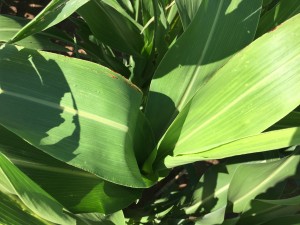This tip was provided by:
Calvin Trostle, Extension Agronomy, Lubbock, 806-746-6101, ctrostle@ag.tamu.edu
High Plains
Abundant, even Excessive Rains, in the Texas High Plains—Implications
1. Are your weeds boing berserk?
The latest sorghum is moving toward boot stage though cooler, cloudy weather may have slowed it down. Pigweed has become a problem in some fields. Every weed control herbicide you put out earlier is giving reduced or even little control due to rain after rain in some areas. You may have pigweed that is already 6” or even 12” tall. Options for late season weed control could include Huskie (up to 30” tall grain sorghum, but before flag leaf emergence) or Peak (up to 30” tall, but prior to heading). There really aren’t any tank mix options. Fortunately for some growers the canopy is thick so that may suppress some weeds. I have only given a few details on these two chemicals, so ensure you read the label. There might be another rescue option or two, but I am not sure what that would be.
2. Some grain sorghum is showing pale green to light yellow color on younger leaves coming out of the whorl (Fig. 1).
Due to all the rain, any N applications you made may have been diluted and move downward such that you are now insufficient in nitrogen. Given time, N will move to these younger leaves and they will green. This is not to be confused with the yellow striping between the leaf veins, which is iron deficiency. Lack of iron (Fe) can occur in waterlogged conditions, but I have not seen this yet in the current High Plains grain sorghum crop.

Fig. 1. Light yellowing of most recent leaves may indicate temporary nitrogen deficiency due to leaching of nitrogen in the soil.
By the time sorghum heads out about 70% of N that the plant will require (if it is available) will already be in the plant. Some producers have asked about foliar feeding, but that is only a viable consideration when you can readily deliver a few pounds of N to the crop and absorb the much higher cost per unit of N that foliar feeds represent. For an acute deficiency, a producer looks for a way to deliver a larger amount of N, but we are so late in the season with most sorghum that we don’t normally recommend larger N applications now. Applying a small amount of N now might help, but for the plants represented in Fig. 1, I would say ‘do not apply.’ If you are spraying for sugarcane aphid and your crop is pale, then inquire if a few pounds of N in a product that will be compatible with Sivanto or Transform.
3. Sugarcane aphid in the High Plains is a concern (I hope this is not a surprise)
SCA is now surely present in all counties even if it hasn’t been reported. Infestation levels range from thousands per leaf (most likely the central and lower South Plains and to the east) to first observations the past 10 days (northwest South Plains, Texas Panhandle, eastern New Mexico). With all the rains we have had, based on previous years observations, we might have expected this to set sugarcane aphid back. It didn’t happen. SCA were reaching economically damaging levels shortly after some of the recent rains. Also, producer here have heard how much less SCA was downstate, but at Dr. Pat Porter, AgriLife Extension entomologist, Lubbock, noted, the entomology group believes that the High Plains are different conditions than downstate. Finally, some of our IPM agent newsletters have mentioned that there have been, at least up to about two weeks ago, few beneficial insects present.
Bottom line for SCA, Texas High Plains, 2017: Do not be complacent. You must scout your fields. Tolerant sorghum hybrids may help, but they are not immune, and are all susceptible to SCA at some level. The fact that we have all heard that SCA was less a problem downstate means nothing. The farmer that has a field in Lubbock Co. that recently averaged well over 1,000 aphids per leaf learned this the hard way. I am pleased to report that several of my own SCA sprays (Sivanto, 5 oz./A, 12 gallons/A with my backpack sprayer), show no re-infestation of SCA almost 3 weeks later. Also, if you are only after SCA, do not add Lorsban to your spray (some growers report receiving this advice from applicators). Lorsban, though inexpensive, is not needed for aphids, but only kills your beneficials, and you in fact may be worse off.








